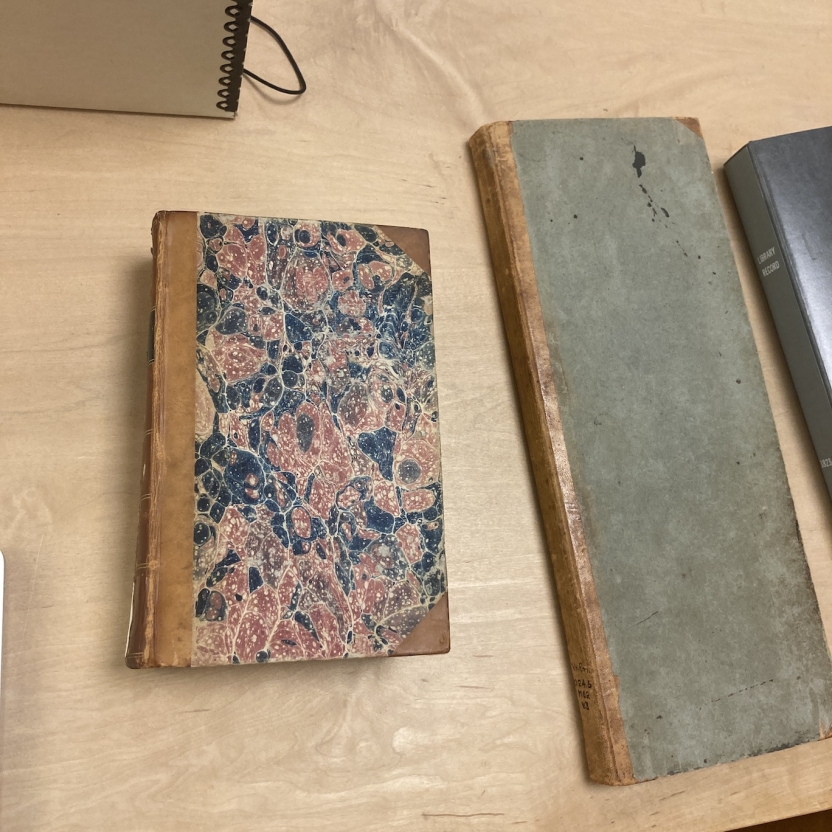Archival Sleuthing: Inspirations for the First Electric Motor

Did a Middlebury professor read a scientific journal in the 1830s that led to the invention of the electric motor? A bit of archival sleuthing solved the mystery.
Recently a researcher phoned Special Collections with a seemingly simple question: When did Middlebury first subscribe to The American Journal of Science and Arts? Considering that the publication began in 1818 and is the country’s longest-running scientific journal, and that Middlebury was founded in 1800, it’s a reasonable guess that the College might have started its subscription at the very beginning of the journal’s publication history. However, the researcher needed to know whether the journal was available on campus on a specific date – the occasion of Brandon blacksmith Thomas Davenport’s visit to Middlebury science professor Edward Turner sometime around 1832.
Thomas Davenport has been forgotten, but his contributions to technology and modern life cannot be overstated. He invented the first electric motor ever patented.
The researcher noted that in 1831, Albany resident, physicist, and future Smithsonian Secretary Joseph Henry published his research and findings on electromagnets in The American Journal of Science and Arts. Davenport and his wife Emily purchased one of these electromagnets to begin developing an electric motor. Perhaps because Professor Turner had read this article, he encouraged Davenport to patent his idea and collaborated with him on the design. But did Turner read Joseph Henry’s findings?
The catalog record for the print journals in Special Collections didn’t note when they were acquired, so the next step was to examine the bound journals to search for clues about when the College might have added it to the collection. Sure enough, a familiar 19th-century annotation on the first page indicated it was the 2,620th volume to join the library collection.
Confirmation in the first library accession book verified that this was the volume purchased by the College. Unfortunately, a heading the page prior noted that the journal volumes were added to the collection after August, 1836, later than the meeting between inventor Davenport and Professor Turner.
Luckily, we library workers are a tenacious bunch, and I wasn’t ready to accept the notion that Professor Turner hadn’t seen these journals. Did he have a faculty file containing correspondence about the publication? No. Could it have been mentioned in historic faculty meeting minutes? Too minute a detail. As one of two science professors at Middlebury, where else might he have gone to consult this important publication?
Then, inspiration struck – The Philomathesian Society!
Started by students shortly after Middlebury opened, the Philomathesian Society was a literary club that met weekly to debate issues, read original compositions, and – most importantly for this research question – had their own library that rivaled that of the College.
They also produced a library catalog and kept circulation records, and it is in these volumes that we find Professor Edward Turner consulted the journal. The numbers assigned to the The American Journal of Science and Arts correspond with numbers listed in the Philomathesian Society circulation records under Turner’s name.
Because the copies of the journal acquired by the College Library (not those purchased by the Philomathesian Society) are the ones that survived and now reside in Special Collections, we can’t know for certain that the journal volumes Turner consulted are the volumes that contain the articles on electromagnets. Nonetheless, the evidence that the journals existed at Middlebury and that Turner accessed them, strongly suggests that he was familiar with the technology underpinning Davenport’s invention.
That’s about as close to an answer as we can get in the archives! History is constructed through interpretations of primary sources like these that inform our understanding of the past. Nothing is certain, but we are fortunate to have access to these materials that guide us on our search to better understand the lives and experiences of those that came before us.
A note on privacy: Today, this sort of information is protected. A patron can check out a book, and libraries will not divulge which books the user accessed. However, as with historic demographic information about students (before FERPA protected that information), we do share archival materials that reflect library circulation records.
Sources
Bushnell, Mark. “Then Again: Fame eluded Brandon man who invented the electric motor.”VT Digger, July 3, 2022, https://vtdigger.org/2022/07/03/then-again-fame-eluded-brandon-man-who-invented-the-electric-motor/. Accessed August 16, 2024.
Stameshkin, David. The Town’s College: Middlebury College, 1800-1915. Middlebury College Press, 1985.

